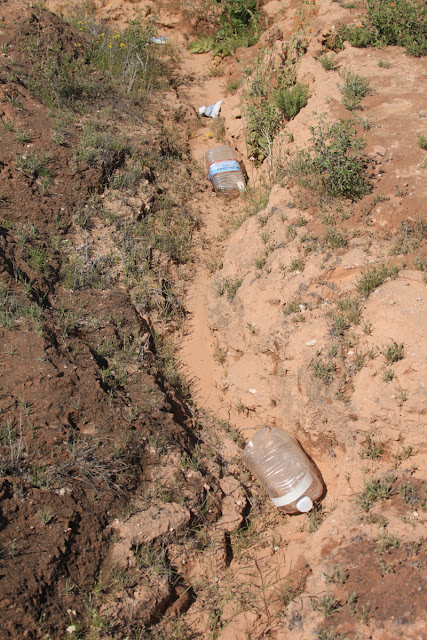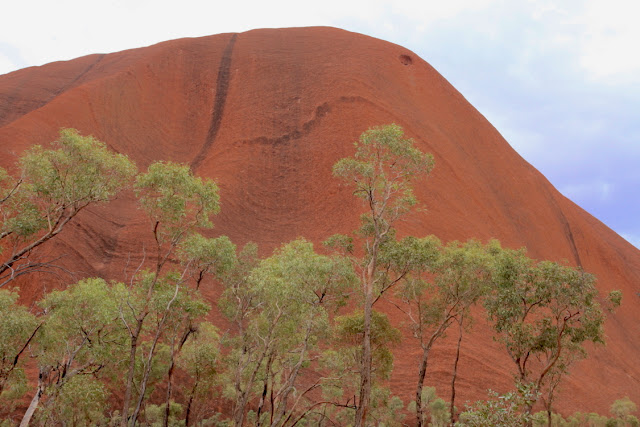Antoine de Saint-Exupéry, French writer, poet, aristocrat, journalist, and pioneering aviator
And so it goes. Where there is nothing, often there is everything. I think that is why I love the desert. Although I am not strictly a religious person, I revel in the fact that many of humanity's greatest and largest religions originated in desert environments. One feels close to God, perhaps, because one can see farther in the desert. I wonder if many people ever think of the environment where their belief system developed? Does it matter? Why do people in North and South America hold on to traditions originating from the Middle East? I think about these things while traveling along the smooth, hard roads in the desert. I also think about geology - time travel at its finest. Brace yourself - there is a wonderful geologic story about this place below!
I've had a long-time desire to see and visit the historic Tinajas Altas (meaning High Waterholes in Spanish), located in extreme southwest Arizona, along a historic route known as El Camino del Diablo (The Devil's Highway). People have been coming to these hidden pools along the Camino as long as there have been people here - nearly 13,000 years! And before the self-isolation of the current times began, myself and some friends planned a nice four day trip to this hidden oasis.
The Tinajas Altas Mountains are located within a one million acre+ military reservation known as the Barry M. Goldwater Range. Every person on our trip was required to fill out an online permit to enter the range for recreational purposes. It is located between Tucson and Yuma along the Mexican border in southwest Arizona and was created immediately after the Pearl Harbor bombings to train fighter pilots for that war effort. We made a base-camp for three nights in one place and explored a few areas from there. The Cabeza Prieta National Wildlife refuge abuts the bombing range on the east.
Signs like this were evident everywhere to discourage off-road exploration. This trip is not for the faint of heart as jets come seemingly out of nowhere, buzzing the desert floor on training missions.
DAY 1 - El Camino del Diablo Este
Sign announcing the northern boundary of the range.
My only surprise is that there are not more bullet holes in this sign.
After about 24 miles of dirt travel, a sign announces the location of the once hard-to-find waterholes.
A view of our base-camp looking toward the east on our first day. In the background are the Cabeza Prieta Mountains. Love those cirrus clouds framing them!
DAY 2 - Visiting the Tinajas Altas
On our first morning we went 1/2 mile south to the water holes. This large granite boulder contain an opening that could easily fit five to six individuals during a hot summer day or spring rain storm. Something like this would obviously serve prehistoric populations well! The rocks belong to the Gunnery Range batholith, a moderate-size intrusion from the Late Cretaceous period (batholiths by definition are larger than 100 square miles.
The Tinajas Altas Mountains belong to the Basin and Range Province, where blocks of the Earth's crust pulled apart and rotated beginning about 17 to 20 Ma (Mega-annum or millions of years ago). The event created long, uplifted ranges, separated by parallel and adjacent down-dropped basins. This occurred from southern Oregon into northern Mexico and out east to west Texas. Both the ranges and the basins appear linear on the landscape (see the trend of the Tinajas Altas and Mohawk Mountains on the map at the top).
The Tinajas Altas are composed of granite that was intruded as magma into the crust about 70 Ma. At that time, the Farallon oceanic plate was being subducted beneath the western edge of North America. This crumpled the crust well enough, but it also caused an influx of volcanism, as melting commenced at depth on the down-going oceanic plate. The melting formed granite, which you see in the photo above. In the last 70 million years, the overlying rocks that contained the magma have eroded way.
This is what southwest North America looked like about 70 Ma. (Note the modern state and county lines overlain on this ancient geography for reference from the book, "Ancient Landscapes of the Colorado Plateau", by Ron Blakey and Wayne Ranney). The red dot denotes the location of the Tinajas Altas Mountains. This is where the Gunnery Range Batholith was intruded into a large mountain range known to geologists as the Mogollon Highlands. The Pacific Ocean is located in the extreme southwest corner of the map. There were short, steep rivers running southwest out of the Mogollon Highlands to the Pacific. And very long, low-gradient rivers running northwest all the way into the Mississippi River system at this time. Think about that!
To further explain, I have overlain a map of the Amazon drainage in modern-day South America over that of modern-day North America. South America is a perfect modern analog for how the landscape and drainage pattern looked in the Late Cretaceous period in North America. In South America above, the Andes Mountains are the source of the Amazon with flow across the entire continent to the Atlantic. In Cretaceous North America, rivers rose in the Mogollon Highlands and flowed across the future Colorado Plateau and Rocky Mountains region into the Gulf of Mexico. What a joy it was to visit the roots of the ancient Mogollon Highlands in the Tinajas Altas Mountains!
Then, after the passage of 70,987,000 years, people arrived leaving their mark on the landscape near the thirst-quenching pools of fresh water. These are grinding pits called metates where people processed wild seeds near the tinajas.
The first and bottom-most of nine pools.
A few others in our group scrambled up to see pools two and three. I was unable to do that recovering from knee surgery.
Who knew Chuckwalla's love the taste of brittlebush flowers!
DAY 3 -To the Cabeza Prieta and Christmas Pass
Not your usual sign when undertaking recreational pursuits.
God only knows what this mannequin is supposed to represent or do. There was a live flare in its holster so perhaps if someone is in dire trouble they would approach anything that looked human and use the flare.
Evidence that walkers have been through here.
We saw many of these beautiful Desert lily's blooming (Hesperocallis undulata). They are also called Ajo lily's because of the bulbs garlicky flavor.
This is the feature that gives the Cabeza Prieta Mountains their name, Cabeza Prieta Peak (elevation 2485 ft.). Cabeza Prieta means Black of Dark Head in Spanish. A remnant black lava flow caps the light-colored Gunnery Range Batholith. When the Basin and Range Province was formed, andesitic magma welled up through the weakest parts of the extending crust to erupt these lava flows. Radiometric dates have been obtained from these lavas. The flow on the peak is dated on Potassium/Argon, whole rock at 16.12 Ma and a dike is dated on hornblende minerals at 17.81 Ma. These dates are clearly within the timeframe of Basin and Range extension.
Finally, we arrived at Tule Well, a well-known source of water that was hand dug in the 1850s. The giant dump truck is coming back for another load of sand to be used in the construction of the new border wall.
The dirt track was quite busy with construction traffic. Out of the 11 folks in our group, 10 of them thought the construction of a new wall was a waste of money.
Scorpion weed (Phacelia crenulata) is part of the Waterleaf family of plants with over 100 different species in Arizona.
Thanks to reader Barbara Yarbrough who correctly identified this as Miniature Woollystar (Eriastrum diffusum).
A Desert sunflower (Geraea caneacens) grows in front of the door of the adobe cabin built in 1989 at Tule Well.
A field of Desert Sunflowers in bloom. I would say that we hit the peak of flowering in this low desert spring bloom.
I couldn't tell if this was Teddy Bear cholla (Cylindropuntia bigelovii) or one of the other Cylindropuntia's. But I'm going with Teddy Bear cholla.
DAY 4 - El Camino del Diablo Oeste
Originally, we had hoped to enter the area from the east through Organ Pipe Cactus National Monument and work our way west. However, the intense rains that this area experienced just before our arrival made that a difficult route to travel. So we stuck to to the western side of the Goldwater Range where the granite soils were drier and more manageable. Therefore, we exited the area on the western branch of El Camino del Diablo. This route follows the western base of the Tinajas Altas Mountains. The flame-tipped ocotillo (Fouquieria splendens) was in full bloom!
Close-up of the flame tips.
Beautiful desert drive!
Saying good-bye for now to the Tinajas Altas Mountains. Rich geology, colorful plants, clear skies, and wonderful friends. We did however come back to a much different world.







































































